August 29, 2016
Two months ago, I visited the Peak Brain Institute in Los Angeles, California for a special type of advanced brain scan and brain mapping system called a quantified electroencephalography, or “QEEG”…
…and I was shocked at what they discovered in my brain.
Dr. Andrew Hill, who oversaw the test and who you may remember from my podcasts “Can Weed Really Shrink Your Brain” and “The Little Known Truth About Smart Drugs And Nootropics” (and who you also may have seen on The Joe Rogan Experience, the Smart Drug Smarts show and beyond) discovered some pretty severe patterns of excess stressful beta waves, excess theta waves, and excess delta waves in my brain.
What's that mean?
Basically, this suggests that I have had some history of concussions and traumatic brain injury (which I indeed have had, in everything from football to mountain biking to kickboxing), as well as built-up deficits of attention, increased distractibility, limited sleep potential and less-than-optimal cognitive performance from life, travel, toxins, head injuries and beyond.
So last week, I hopped on a plane to LA, and went back to the Peak Brain Institute for three days of intensive training to fix my brain.
In this guest article from Dr. Andrew Hill himself, who is one the leading neurofeedback practitioners and peak brain performance coaches in the country, a UCLA trained cognitive neuroscientist, lecturer, entrepreneur, avid biohacker, and host of the soon-to-be released podcast – Head First With Dr. Hill (stay tuned as one of the first episodes is with yours truly)…
….you're going to discover exactly what I did with Dr. Hill, how this method of brain fixing blows any other form of electrical brain stimulation out of the water, and how I felt while going through what is essentially like “meditation on steroids”.
Enjoy.
————————–
You Are An Athlete
The 2016 Rio Olympics games have just come to a close, and it will be a long wait until Tokyo Games in 2020. It’s going to be an intense, grueling four years as athletes try to get to the top of their game. But for most of us, our Olympic dreams probably died somewhere around the beginning of high school…the ultimate reality check…the point when you realize that you’re not going to be the next Michael Phelps or Simone Biles.
Then why is it that we care so much about what the best athletes in the world eat, sleep, and breathe?
We’re competitive by nature because we’re human. Like Ben, we want to be the best, have the best, and live life to its fullest. We’re also flawed by nature because, you guessed it, we’re human. We get anxious, impulsive, distracted, stressed out, lose our confidence – and sometimes even lose our cool.
In other words, we seem to get in our own way a little too often.
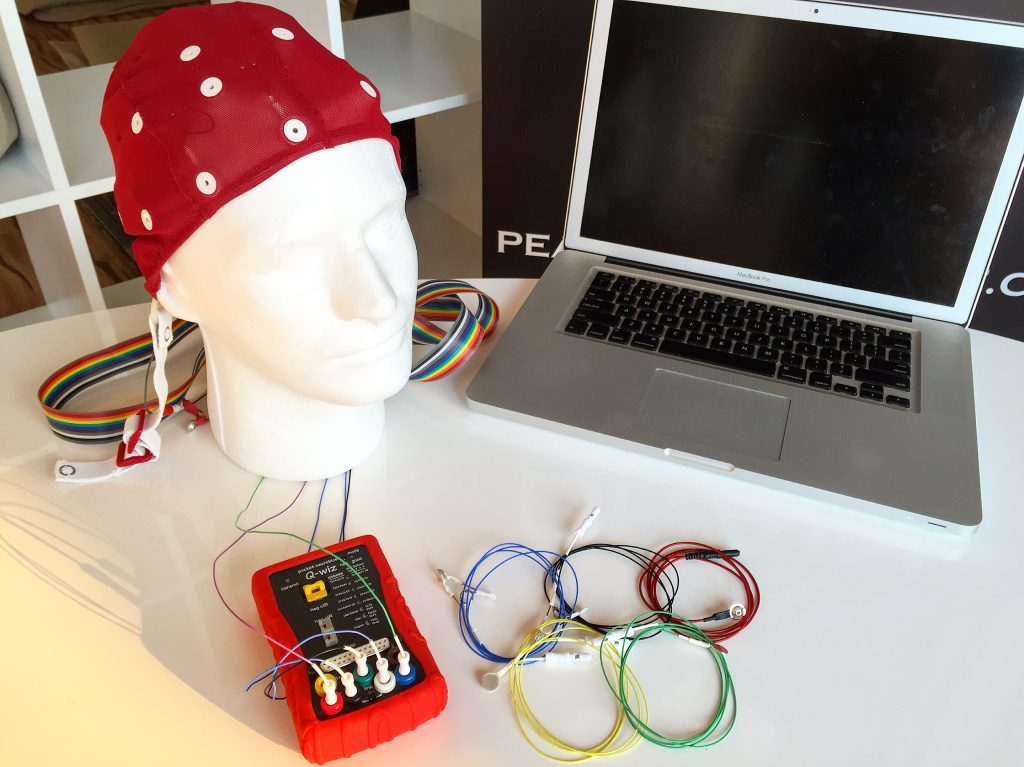
So maybe you don't consider yourself to be an “elite athlete” – but regardless of that, if our professions are mentally athletic or physically athletic in nature, our successes and failures are largely dependent on what happens inside the three pounds of tissue between your ears. Whether you’re a surgeon, Wall Street trader, neighborhood butcher, or super mom, life is really a game of inches, and much of that game takes place in that organ between your ears that we call the brain.
————————–
Olympic Glory vs. Eternal Agony
Focus and emotional balance is the key to peak performance in all areas. Neurofeedback – also known as EEG biofeedback – is used by many athletes, including the recently competing USA Olympic athletes, to train their brains to function better during performance states. EEG was originally used to treat conditions such as epilepsy, attention deficit disorder and migraines, but contrary to popular belief, can benefit all brains.
Neurofeedback trains your brain to function more efficiently, improving mental functioning and emotional regulation. Much like physical training, you can use brainwave training to strengthen specific brainwave (EEG) patterns. The more you practice you have activating or entraining a specific area of the brain, the stronger and more accessible those resources become.
Neurofeedback was discovered in the late 1960s by sleep researcher Barry Sterman, PhD, who discovered that he was able to train cats to produce more of a specific EEG pattern by reinforcing it with a positive reward. This specific rhythm, in a frequency of 12Hz to 15Hz, over the sensorimotor part of the cortex is called “SMR”, or sensory motor rhythm. If you’ve ever seen a cat lying on a window sill looking out the window at birds, you have seen SMR. Body like liquid, but eyes in a laser-like calm focus.
That’s the SMR state – a feline version of “the zone,” if you will.
————————–
Getting Your Head Into The Game
Our bodies follow the brain every step (and misstep of the way). Athletic performance is truly a function of brain-body connection. With so much at stake, it’s almost a no-brainer for an Olympic athlete to hone their mental game in addition to their rigorous physical training. Many athletes have realized that neurofeedback is one of the best ways to keep their mind controlled and focused so their body can perform at its best.
The Italian National Soccer team kicked up their performance by using neurofeedback and won the 2006 World Cup after edging France with clutch penalty kicks. Olympic Beach Volleyball champion Kerri Walsh-Jennings has incorporated neurofeedback into her training routine for years. Alexandre Bilodeau, the Canadian men’s mogul champion credited his gold medal to neurofeedback. Bilodeau used it to stay relaxed between runs.
Elite athletes across the world incorporate neurofeedback into their training – from the United States Olympic Training Center, US Special Forces and Navy Seals, NFL, NHL, the Pro golf circuit, Formula 1, and even NASA.
These athletes use neurofeedback training to:
- Increase focus and attention – focus is essential for athletes – they must stay completely in the moment and pay attention to every detail
- Improve the depth and quality of sleep – deep, restorative sleep is often directly correlated to performance
- Increase neuroplasticity – which may help the central nervous system better cope with stress
- Eradicate one-way, negative thinking – confidence is key – streaks and slumps are the enemies of elite athletes
- Keep the brain young and brain fitness high – neurofeedback can help preserve that cognitive edge over time
In a nutshell, these superhumans use neurofeedback to overcome their personal kryptonite, whatever that may be.
————————–
What’s your Kryptonite?
For some of us it’s lack of sleep, but for others it’s anxiety getting in the way, distractibility and lack of focus, impulsivity, obsessions, constant worrying, or debilitating migraines.
Maybe it’s the years long lingering effects of a concussion or traumatic brain injury causing the mind to fatigue as the brain seems to “brown out” by mid-afternoon.
For Ben, it was a little bit of everything.
Whatever it is, most of us seem to have something cognitively that holds us back from achieving our goals.
Could it be a chemical imbalance in the brain? No. In fact, there’s no such thing as a chemical imbalance in the brain. This idea might help sell billions of dollars in pharmaceuticals, but it’s a big fat myth.
So how can we better understand our weaknesses and cognitive challenges?
Enter brain waves.
————————–
What are Brain Waves? What Do They Mean?
One thing people often aren’t aware of is we’re making all of our brain waves all of the time. You’re making waves we call “Delta”, “Theta”, “Alpha”, “Beta”, and “Gamma” all of the time, but the amount of different frequencies you make change moment to moment. They track your states and your resources to some extent. Brainwaves in proper ratios are like musical instruments coming together in an orchestra – nothing too loud, nothing too quiet, with a harmonic beat, and all players additive and cooperative.
These brain waves are also known as EEG, and are simply electricity, produced by organized assemblies of neurons firing at the same speed. Largely when we train the brain, we are measuring these brainwaves. Based on the speed of these oscillations, we call them Delta, Theta, Alpha, Beta, or Gamma.
For example, Delta is good when you're sleeping, but bad when you're awake. Excess Delta may mean sleep deprivation or past head injuries. Chronic and excessive alcohol consumption may suppress the slow brain waves including Delta, Alpha, and Theta. The Delta frequency is 0.5 Hz – 4 Hz.
Then there's Theta, which is good for creativity, but bad for focus. Excess Theta shows up in impulsivity and lack of control over performance. When this happens, it’s like the brakes being off the car. Everything becomes reactive and there’s very little inhibitory ability and carefully directed behavior. The Theta to Beta ratio is a very well validated marker for ADHD and other executive function problems (high TBR indicates ADHD). Theta is 4 Hz – 7 Hz.
Next is Alpha, which I call an idling or rest frequency in the brain. It is good for relaxation, but bad for focus. Excess Alpha shows up in inattentive ADHD, and may show up with chronic abuse of cannabis. Alpha is 7 Hz – 12 Hz.
Beta is good for alertness, focus, and cognition (thinking), but bad if you're stressout. Excess Beta shows up in sleep issues and anxiety. Low power Beta can also show up in head injuries. Beta is 12 Hz to 38 Hz.
Finally there's Gamma, which is a very fast frequency that is possibly involved in consciousness. Gamma briefly binds neurons together into networks. Gamma cannot be measured at the scalp without special equipment, and must be measured at cortex (putting electrodes into the brain) or using very expensive active electrodes. Gamma is 38 Hz and higher. Long term meditators have enhanced Gamma, and schizophrenics have reduced Gamma.
————————–
How To Map Your Brain
Before starting any neurofeedback training, it’s crucial to have a Quantitative EEG (QEEG) or ‘brain mapping’ performed. This is essentially a statistical analysis and assessment of functional patterns in your brain that gives great insight into how your brain compares to a range of typical brains. It can identify potential cognitive challenges and bottlenecks.
Below is me pointing out a brain map (and, as an interesting aside, this particular form of therapy “re-sensitizes” one to the use of cannabis, if that's your thing).

A QEEG starts by measuring your resting state brain waves from about two dozen locations across the scalp, both with eyes open and closed. This data is then compared to a normative database of several thousand people and results in a several hundred page report of statistical maps that utilize Z-Scores (-3 to 3 standard deviations).
If a functional area of the brain is 2 or 3 or more standard deviations from the norm, this is a sign that this is an area that we want to take a closer look at. If you recall your basic statistics 2 standard deviations includes 95% of the bell curve and 3 SD includes 99.7%.
It takes a very skilled clinician to understand and interpret the data. And, the data shouldn’t necessarily be believed unless it matches the subjective experience of the person it came from. Just because someone’s brain is unusual (there is no such thing as a “typical” brain), it doesn’t mean there is a problem. QEEG is not a diagnostic tool – you could say it’s ‘prognostic,’ because it tells us what is likely true.
If the QEEG data matches the experience of the person being test, then you should trust the data. With this knowledge, you have the basis for a training protocol.
————————–
Fixing Your Brain With Neurofeedback
Training with neurofeedback is intense exercise for your brain.
However, there’s a few key distinctions to be made from brain training and physical training. First, you don’t have to break a sweat – just kick back in a comfortable chair. Second, you don’t even really need to try – just be present and sit relatively still (muscle tension can interfere with the electrode signals). Three, the software is adaptive and always moving the goalposts, so there’s really no such thing as winning or scoring a PR – it’s time under a training protocol, not “score.”
And lastly, the most impressive difference is that with sufficient training, neurofeedback can produce lasting effects and new resources, unlike the transitory effects of physical training.
So what exactly is neurofeedback?
Neurofeedback is a non-invasive form of central nervous system biofeedback. It trains the brain to develop new resources by encouraging certain areas to raise or lower the amplitude of particular brainwaves (or it can train connectivity, ratios, etc). To a very large extent, and unlike peripheral biofeeedback such as practicing a physical exercise like a handstand, neurofeedback is an entirely non-voluntary process where you are shaping the brain by thresholding and giving the brain feedback only when it’s doing certain things. Professional clinicians report that about 90% of users notice significant positive impact from the training.
Training simply involves the placement of electrodes on the scalp to be picked up by an EEG amplifier. These signals are then fed into software that then sends back to the user some form of visual and/or auditory “feedback” or reward. This reward stimulus is given when the brain produces brainwave changes in amplitudes or frequency in the direction we want to encourage.
The single most crucial aspect of neurofeedback training is protocol selection. Neurofeedback is a powerful tool and every brain is different. Although the QEEG provides crucial information about one person’s brain, the training plan itself needs to be adaptive and iterative, based upon how someone responds to the training, which is why it's important to have this process overseen by a neurofeedback practitioner.
Neurofeedback can produce side effects, although they are generally minor and short lasting – and also informative to a neurofeedback practitioner. If you get adverse effects, protocols can be adjusted to steer the brain in a different direction. But, if you are somebody training yourself with no supervision and no sense of what’s actually happening in the brain, you can easily produce negative side effects and – if you keep doing it – you can cause these negative effects to become permanent.
————————–
Doping Your Brain
No, I'm not talking about Performance Enhancing Drugs (PED's), but even the Russians athletes will readily admit that they rely heavily on neurofeedback as one of the many ways they strive to get an edge. The gear we’re talking about is a neurofeedback home training kit, or finding a skilled clinician in your area.
Most, if not all consumer EEG “wearable” headsets on the market are mostly ineffective, at best. I'm not going to do any name dropping, but you've probably seen these sexy headbands and brain training equipment that, say, syncs to your phone.
Here's what you need to know: any device that measures EEG from the forehead should raise skepticism, as the forehead is almost never the right place to train EEG and training the forehead can produce the most dramatic side effects. There is really no one size fits all neurofeedback.
There’s no magical cap you put on your head and sit back and it just works, period.
Anyone can stick electrodes on heads, set up frequencies in a signal processing algorithm, and tie it to a computer game, using the current neurofeedback software packages in clinical use. But nowing what to do, where on the head to train, what frequencies to train up and down, how to train amplitude, or coherence, or other more complicated metrics and why to do these things (and what to do when you get adverse or suboptimal effects), that’s the difficult part of neurofeedback. This is really why you need a neurofeedback practitioner to guide training or you need to be really technically minded yourself and have some neuroscience perspective.
Otherwise, you’re going to get, at best, suboptimal effects and at worse, potentially adverse effects in the long term.
————————–
Shift Happens
So can you achieve the equivalent of decades of meditation and zen training fancy biohacking neurofeedback equipment like Ben is using?
Let’s not get carried away. Barring something like a brain injury or pharmaceutical and recreational drug use, EEG patterns tend to be static and change very, very slowly from one year to the next, so getting significant changes in a short period of time are a big deal.
Some very positive effects are often noticeable in the first week or two of doing neurofeedback, but neurofeedback training is not “permanent” until you have done something for several weeks – at least 5 weeks – the brain just doesn’t change its patterns that quickly.
Ultimately, you can expect to do neurofeedback a few times a week for at least 3 months to achieve lasting results that meet goals of big shifts in attention and other brain resources.
When you change your brain, you change everything.
You change your entire experience, how you process information, and how you experience the world. The brain is the filter through which you experience absolutely everything. So, subtle changes over several months in your processing machinery can mean dramatic change in your experience and executive function.
————————–
What I Found In Ben Greenfield's Brain
As Ben mentioned in the introduction to this article, he came to Peak Brain Institute in LA two months ago and got his QEEG performed (in a live studio, pictured below, podcast coming soon). We found many patterns of excess Beta, excess Theta, and excess Delta in Ben's brain.
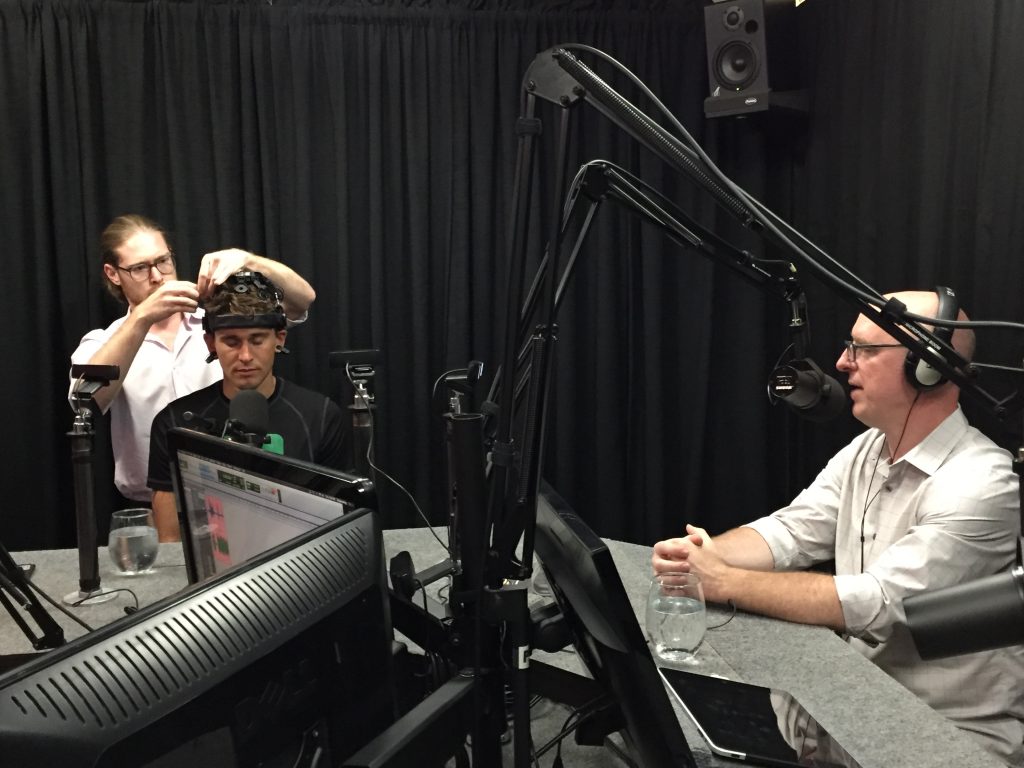
Overall, this suggested that Ben had some history of mild head injury (concussion), and shows some likely bottlenecks in resources for things attention and sleep.
So last week, Ben came back to my institute for three solid days of what I call a “self-training intensive”.
During these three days, we worked with Ben to do further assessments and brain training, and taught him the process of setting up and recording EEG training sessions for himself. We built an personal EEG training kit for Ben and gave him the skills to administer his own training.
Ben then left with a training kit to continue training his brain several times a week, updating Peak Brain Institute and me each day with results and progress. I will continue to monitor and provide support as Ben works through different training regimens to optimize his brain, fix sleep, fix distractibility, increase his IQ and attention, and much more.
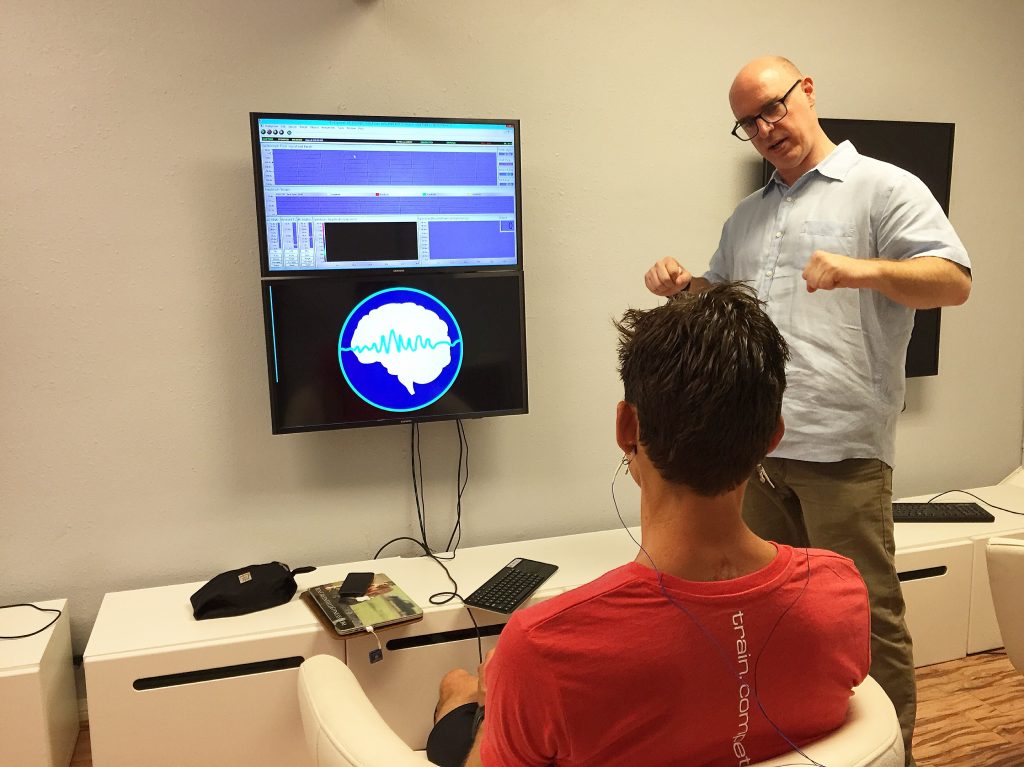
As Ben updates us on his neurofeedback progress, you may be interested in participating in a similar program, so now I'll tell you more about how you can do this type of training yourself.
————————–
Peak Brain Neurofeedback Self Training Kit with Supervised Training
Peak Brain Institute is peak performance center and brain gym founded by me. For those who aren’t able to regularly visit Peak Brain’s Los Angeles Headquarters (or our three other new locations you can view here), Peak Brain offers a supervised home training package. It’s not for everyone, but if you have some attention, stress, sleep, or other broad performance goals, it may be for you, and it's exactly what Ben is doing.
Here's how it works…
Step 1: Initial Intensive
This is an intensive to get you up to speed on self-training your brain. For three days, you will practice training your brain with neurofeedback. This is about the minimum time required to produce some effects, although quick responders will get some effects when they are here.
The first day, we will perform a Quantitative EEG on your brain and teach you about the process of QEEG and what your data means, and then we will furnish you with a copy of your raw brain data for further analysis, as well as a report on clinical impressions of the QEEG with regards to brain performance.
The goals of the Intensive are to help you practice supervised neurofeedback, protocol setup on yourself (or your child or spouse), and learn the process of training, including keeping track of your sessions and progress, learning to use the software and EEG devices, and learning to find scalp locations for training.
Step 2: Two Follow-Up Days
Every day you are here includes a one hour meeting with me, and I will directly oversee your first neurofeedback session each day. You will also practice a second time each day, and later, you can take advantage of our 1:1 mindfulness coaching and our evening mindfulness groups.
Sample 3-day Itinerary
- Day 1: 9 am – 1 pm: QEEG recording, Attention assessment, neurofeedback session, QEEG discussion, and 2nd neurofeedback sessions.
- Day 2: 9 am – 12 pm: Two neurofeedback sessions with 1:1 meditation instruction between them.
- Day 3: Two neurofeedback sessions, kit setup practice, and instruction on charting and logging sessions.
After the Intensive, I send you home with a Peak Brain training kit (pictured below) including:
- Q-Wiz 4 channel EEG and HEG amplifier
- BioExplorer training software
- InnerTube game license and software
- BxShadow software
- EEG electrodes, paste and prep materials
- Gaming-quality 15” laptop (with dedicated video card and current i5 or i7 processor)
- Sleep tracker
- Optional
- pirHEG headset (for passive infra-red hemoencephalography training)
- HRV device (emWave Pro)
- Game controller (Steelseries)
- Cable set (20 foot HDMI and USB cable)
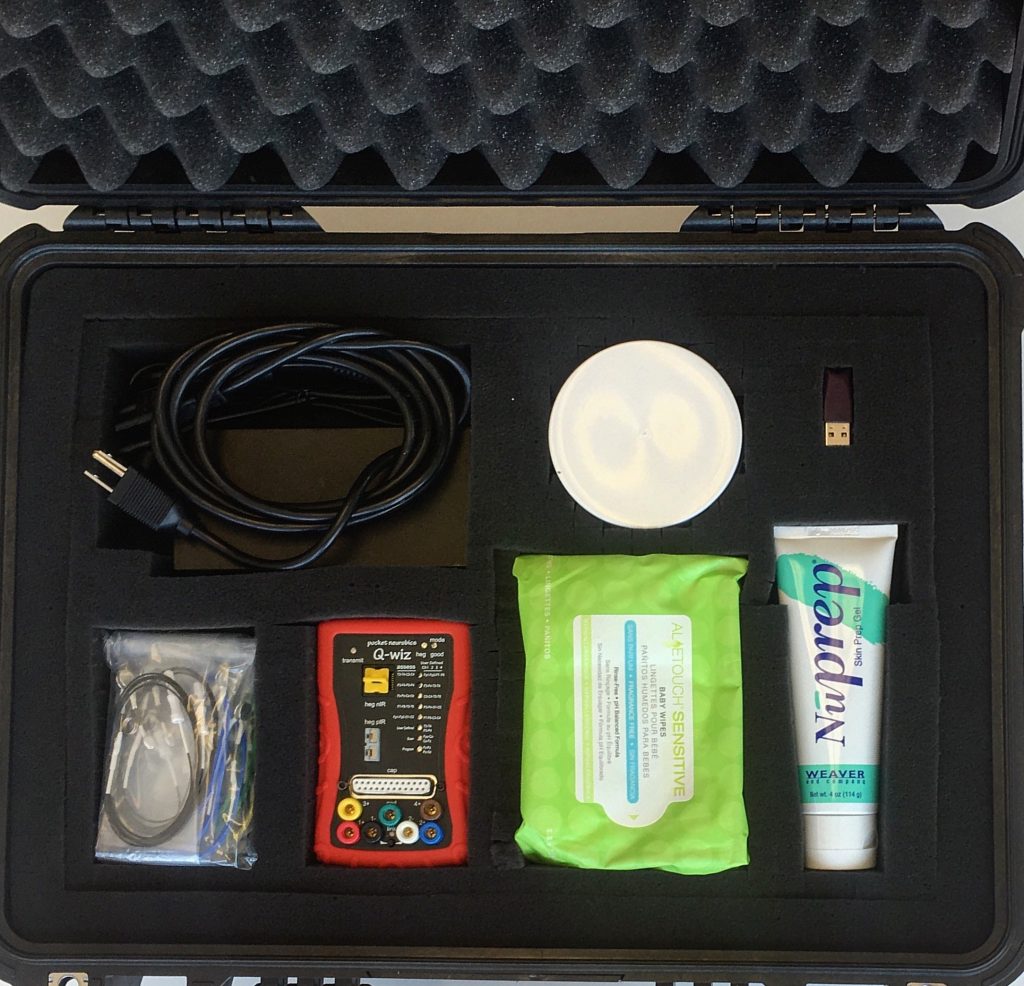
To keep you moving forward with your brain training goals, we then provide training support for a three month period of time. This supervision includes:
- Checking in via text or phone with questions
- We especially want to know how the first weeks of training are going!
- The first few weeks we will ask for weekly calls to talk about your progress.
- Daily, simple survey on 10 aspects of brain performance
- This data reported back to us helps guide your training protocol selection
- Ongoing supervision of neurofeedback protocol selection
- Peak Brain clinical staff will monitor your charts and make adjustment to your training plan weekly or as needed based on results.
- Technical support when using training software
- Call our technicians for support if you forget how to do something
And that's it.
Mention Ben when you visit the Peak Brain Institute website to contact us, and we'll give you the white glove treatment, along with a 10% discount on any of our services, including the exact brain training system that Ben is now using.
—————————-
About The Author
Dr. Andrew Hill is founder of Peak Brain Institute. You may remember him from a few episodes on my Ben Greenfield Fitness Podcast, in which he discussed smart drugs vs. nootropics and how marijuana affects the brain.
He received his PhD in Cognitive Neuroscience from UCLA in 2012, studying how attention operates in the brain, and has been employed as a Lecturer at UCLA over the past few years, teaching multidisciplinary courses on Healthy Brain Aging and courses in Neuroscience and Psychology. Dr. Hill has published chapters on measuring and modulating human attention, and continues to research self regulation.
Peak Brain Institute is Dr. Hill's peak performance center and brain gym headquartered in Los Angeles, and is opening new locations across the country. They offer quantitative EEG ‘brain mapping' and neurofeedback training, HEG and HRV biofeedback, as well as free weekly mindfulness meditation classes and individualized brain training programs like you've just read about (you can use coupon code BEN or mention my name to get 10% off any of the services at Peak Brain).
————————–
Ben Greenfield here. Curious how my brain training progresses, and how my life changes because of this huge biohacking step I've taken?
Me too.
So I'll be releasing updates over my next few months of my brain training, and the absolute best way to keep yourself up-to-date is to stay tuned to my free podcast and to my free newsletter.
Do you have questions, comments or feedback about how to increase your IQ, decrease your distractibility, increase your cognitive performance, and maximize your ability to enter the zone? Leave your comments below and either Dr. Andrew Hill (pictured below on the right, along with me holding my tiny black bag of brain training magic) or me will reply!





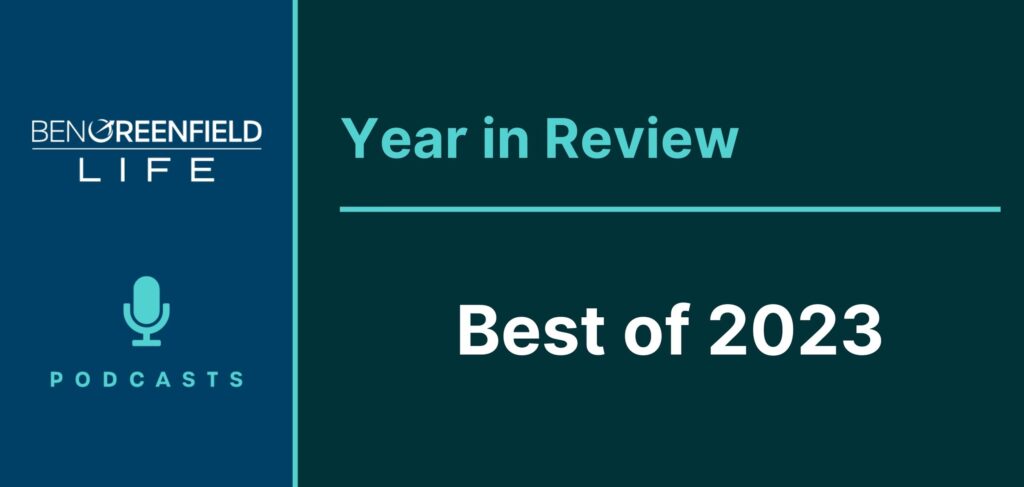




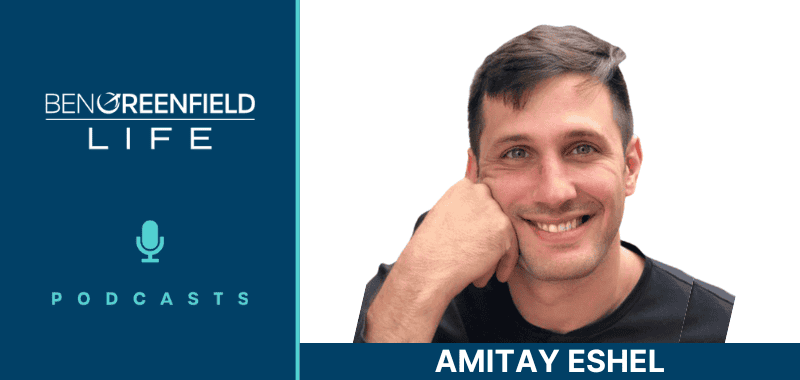




You mentioned an increase in IQ. What kind of results have they seen with their protocols?
What kind of equipment do you use for home training? What brand?
Thanks
Hi there
Just had the brain mapping done yesterday and next week will be my first training session, which January podcast do you discuss the results in?
Thanks
Warren
This one: https://bengreenfieldfitness.com/2017/04/how-neur…
So Ben
it been a couple of months after this post . I’m not on the newsletter feed but would like to know the results of training for a while …Would you give us a synopsis , or link to your writings on the findings?
thanks ted
Yep, recording a podcast in January about it. Results have been profound. And be sure to subscribe to the newsletter. ;)
How does this differ from the NeurOptimal Neurofeedback program? This is an expensive unit one can purchase and simply use it home. Dave Asprey swears by it :)
Interactive feedback from your practitioner and long time training vs just one day or just one week of training is the biggie. You'll interact with your PeakBrain professional constantly the whole time…and the software used is different/more dynamic from what I understand….
The other difference is that there is no session limit on the systems Peak Brain provides. The NO system mentioned above stops working after a prepaid number of sessions, and requires more investment to keep using. Peak uses a BioExplorer system for home trainers, that never expires.
Just want to clarify about NeurOptimal. NO has limits only if you buy a personal system. I own a professional system, me and my family have put hundreds of sessions on the system because there’s no limit. Peak brain is in the linear model of NFB, NeurOptimal is a non-linear dynamical system that doesn’t use normative data bases to decide what’s best for their client. They aren’t really comparable because they are in two different paradigms.
Hi! This is very interesting! I just had a brain map performed for my son, 9, who had a mild concussion in March..but it still having some post-concussion symptoms. He also has a condition called PANS..his neurological system is affected by variables in the immune system. He is also a very gifted soccer player and has had some affects due to both of these concerns sunce March. This is why we had brain mapping. Now, my concern is with our neurofeedback technician..She developed a protocol for my son and is ready to begin sessions. My concern is: Is the mild OCD experienced because of his PANS what makes him a great, intense player OR is it without PANS and now post-concussion concerns that he could continue to be even better? We see, often, negativity and impulsive behaviors on the field. I am afraid that neurofeedback will take away the intensity he has for playing or does this change based on what our practitioner developed as his treatment plan? I am concerned because her comment to me was “to make him behave”. I wonder how I would find another practitioner to review his map and make recommendations as to his protocol. II do not want him “to behave”. I want him to have all of the positive benefits you have listed above. Thanks!
Hi Michelle, thanks for the question! Usually a good neurofeedback practitioner can walk the line between affecting resources and minimizing symptoms. Impulsivity training often provides more resources of *control*, versus dramatically changing fundamental abilities. It strengthens these resources. Most impulsive kids can pay very good attention when the environment is stimulating, but have less control and filtering over “bottom up” processes that drive novelty seeking, pattern matching, scanning, etc. Neurofeedback should help provide more reliable access to modes, but shouldn’t rob your son of any abilities.
The post-concussive symptoms are a bit more complicated, and can take a while to resolve fully. That and impulsivity / OCD like tendencies might mean a bit more “frontal” involvement than simple impulsivity or automatic and quick reactions.
A skilled neurofeedback practitioner can also help you learn from the QEEG: what patterns look like real OCD, as well as possibly mild TBI and other issues. Developing protocol to address the overlap of QEEG findings and clinical presentation is largely what you pay a good neurofeedback clinician for. Talk to yours – look over the data with her and have her explain a bit about why she is doing what she is doing, and what she usually sees when she trains brains this way. You will likely be reassured.
Good luck, and I’m sorry your kiddo is suffering from post concussive stuff – that’s no fun!
Ben- I’m a long time listener and also a Nutritionist at Natural Grocers. Was really excited to see that you’re now ‘part of the team’. Looking forward to more of your articles!
Ben / peak brain
Very cool stuff.
How does this program compare to 40 years of Zen or the biocybernaut institute programs for example?
Are the principles behind quality neurofeedback programs pretty standard in terms of brain improvement & well-being , or are specific programs /protocols prescribed based on findings /needs/goals?
With the at home training and equipment, after making progress is it then a matter of maintenance, or continued progression, and or moving on to different issues (say initially you’re goal was to get rid of brain fog, then you did, then you wanted to sleep better, then you did, then you wanted to improve performance/cognitive ability etc etc – or does the program / training attack that all at once?)
Is there any instances where you guys haven’t seen results/improvement?
It’s a big investment, however if you believe in this training & the efficacy of this specific program – (assuming results are generally as described) this seems like a smart investment.
Ben, what have you seen so far?
Hi Time, thanks for the question! 40 Years of Zen is a very different approach. First, that program is only for 1 week, which is unfortunate, since the brain takes a minimum of several weeks to make big learning / regulatory changes stick. The biggest difference is that our Intensive program leaves you with equipment, skills, and supervision to continue your neurofeedback training for months, to make sure you get the dramatic benefits that can show up with continued training. After a few months you will probably have most needs met, but you can continue training for peak performance goals forever. So our program helps you integrate this technology into your life in a lasting way, with emphasis both on short term needs and long term benefits.
I am less familiar with the 2nd program you ask about, but it looks like they focus on Alpha training, which is a small subset of the possible approaches.
There are indeed different ways to do neurofeedback. Peak Brain tends to stay on the evidence-based side of things, using QEEGs to do assessments, and neuroscience principles to design training programs tailored to one person’s brain and goals. Some neurofeedback practioners use techniques that have no validation (and cannot “work” given what we know about physics) and some other nfb people use recipe books or one-size-fits-all approaches; these folks usually learn from a short workshop or use franchised / prepackaged approaches. Spoiler – one size doesn’t fit all, in neurofeedback – it’s highly individualized when done properly. Most software packages can be configured to do most forms of neurofeedback, but be very suspicious and skeptical of any provider or software that says they have some special or proprietary way of doing things. The heavy lifting in neurofeedback is applied neuroscience, not magic algorithms in “special” software.
For most people, the question about “maintenance” is a nuanced one. Most of the “easy” things to work with in neurofeedback (attention, anxiety, sleep issues, migraines, etc) usually show big shifts and are largely resolved in 3-4 months of training. But many people “fix” a problem and then shift focus to work on building additional resources. Sort of like if you went to a physical therapist to address a body problem, but then continued in a gym after you were recovered. Gains continue to accrue. Some complaints can be attacked at once – anxiety, sleep, and ADHD tend to resolve together, for instance, but other things have to be strategically addressed first. For example, we would want to address anxiety before creativity, since deep relaxation work (which is used in creativity access training) can provoke severe anxiety if it’s not dealt with first.
I have worked with several hundreds of clients, across a range of complaints and peak performance goals. There have been about 5 clients total in all my time doing this that did get great / strong benefits out of this process. At least one of those had major opiates / benzos on board that blunted the effect.
Let me know if you have more questions!
Only five who got great results out of hundreds treated does not see like very good odds!
Ha Ha! Good catch. Surely he meant ” did not”. Otherwise Dr. Hill just admitted his practice is a scam.
Hello, can the neurofeedback training and kit that you have blogged about help with epilepsy?
Hi Sarah, Thanks for the question. Andrew Hill, here. The answer is “probably”. Neurofeedback was actually discovered *because* it reduces seizures. It’s difficult to say how any individual person’s brain would react, but I have reduced or eliminated seizures in several people, among other complaints we have successfully addressed.
Ben really has taken this site and his podcast to the next level. This stuff is all mind-blowing. It’s a shame some of these protocols aren’t more available to the general public, but Ben’s endeavors seems to have reached a level of complexity where medical supervision is necessary for effectiveness and even safety. Can’t wait to see where this technology is in 10 years.
Thanks for the comment! This process has been around for over 50 years, but hasn’t changed dramatically in that time, other than the technology costs coming down dramatically over that time. The great thing about neurofeedback is that it is *not* medical, but can be used to train any brain – one with problems or not. The supervised 3-month program at Peak Brain is to give you the skills to use this technology long term on your own, although the first 3 months should produce long lasting changes for many people.
Hi Danny,
Thanks for the comment. You’re right, it really is a shame that technologies like neurofeedback aren’t more readily available, which is why we’re leveraging technology to bring down the cost and make it more accessible. But, more importantly, we’re treating brain fitness like physical fitness – you can come to our brain gym or train from home and we’ll be your coach.
As far as the future, we’re very excited too. In fact, we’re currently raising capital and looking for hardware and software developers because there’s some low hanging fruit in this space.
How much does the home package cost? It doesn’t list on their site.
Didn’t want to schedule Consult to find out if I couldn’t afford it.
Thanks for the interest! For the remote supervision and intensive in the LA office, it costs $3750 for the EEG training equipment (yours to keep), $2500 for the 3-day intensive, and $1500 (total) for the first 3 months of supervision.
Great question. I went into a little more detail in a comment above, but the package is $3,750 for the equipment and software licenses, plus $4,000 for the intensive with Dr. Hill and 3 months of supervised training.
What is the cost? I don’t see a me room of it here or the link on dr hills website.
Thanks for the interest! For the remote supervision and intensive in the LA office, it costs $3750 for the EEG training equipment (yours to keep), $2500 for the 3-day intensive, and $1500 (total) for the first 3 months of supervision.
Read more https://bengreenfieldfitness.com/2016/08/how-to-i…
Hi, Neil,
Derek from Peak Brain here. The program costs $3750 for the equipment kit (which is yours to keep), and cost another $4000 for the intensive in the office with and the 3 months of supervision. That is usually enough time to make big changes in attention, sleep, mood, stress, etc., and by that point people are pretty comfortable continuing to self-train if all needs are not yet met. We are also available to provide additional supervision if you need it beyond that.
Is anything Such available In India??
warm Regards,
navneet
Hi Naveet,
I’m the Director of Operations here at Peak Brain Institute. We work with clients from all across the globe. The only caveat for you being in India, is that we’d need for you to come to Los Angeles for 3 days for the intensive where we do your QEEG and you work one-on-one with Dr. Hill doing neurofeedback and learning how to use the home training kit that you’ll take back with you.